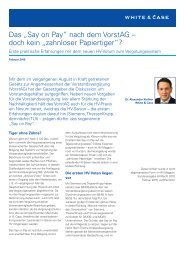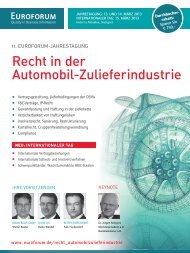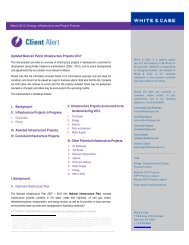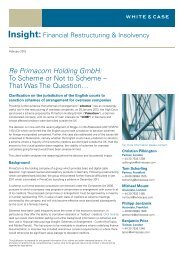Mexican Legal Framework of Business Insolvency - White & Case
Mexican Legal Framework of Business Insolvency - White & Case
Mexican Legal Framework of Business Insolvency - White & Case
Create successful ePaper yourself
Turn your PDF publications into a flip-book with our unique Google optimized e-Paper software.
All assets acquired by the concubine or the spouse under the separation <strong>of</strong> assets<br />
regime in the two years prior to the beginning <strong>of</strong> the retroactive period are rebuttably<br />
presumed to belong to the debtor and, therefore, are included in the estate [LCM 187].<br />
l. Separation<br />
Any legitimate title-holder (not necessarily an owner) may separate individually identified<br />
assets in the debtor’s possession, provided such assets were not transferred to the<br />
debtor pursuant to a final and irrevocable legal title [LCM 70]. To be separated, an asset<br />
must: (1) be in the debtor’s possession; (2) be individually identified; and (3) may not<br />
have been transferred pursuant to a final and irrevocable legal title.<br />
i. In Debtor’s Possession<br />
An asset not in the debtor’s possession shall not be separated. Possession is a<br />
technical term that implies a de facto power over a certain asset and includes not only<br />
assets over which the debtor has physical possession, but also assets over which the<br />
debtor has primary possession (e.g., the debtor shall be deemed to be in possession<br />
<strong>of</strong> an asset even if the debtor has leased it out to a third person).<br />
ii. Individually Identified<br />
The identity <strong>of</strong> the asset is a necessary requisite for separation. Therefore, a fungible<br />
asset (e.g., money) cannot be separated unless it can be individually identified.<br />
In the case <strong>of</strong> accession (i.e., the case where one asset is naturally or artificially<br />
incorporated into another asset), the rules for identifying assets become casuistic<br />
and generally rely on who acquires title <strong>of</strong> the resulting asset. The determination <strong>of</strong><br />
who acquires title requires applying rules governing the question on which is the<br />
principal asset and which is the accessory asset. If, pursuant to these rules, the<br />
debtor becomes the owner <strong>of</strong> the resulting asset, the debtor may have to indemnify<br />
the owner <strong>of</strong> the incorporated asset (which claim would have to be subject to the<br />
insolvency proceedings), but if a third person becomes the owner <strong>of</strong> the resulting<br />
asset, then such third person may separate it, indemnifying the debtor. The level <strong>of</strong><br />
<strong>White</strong> & <strong>Case</strong><br />
47
















